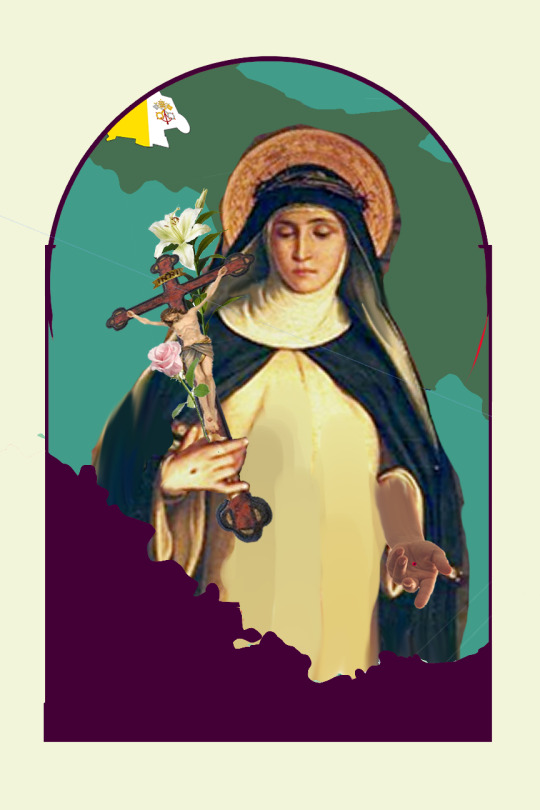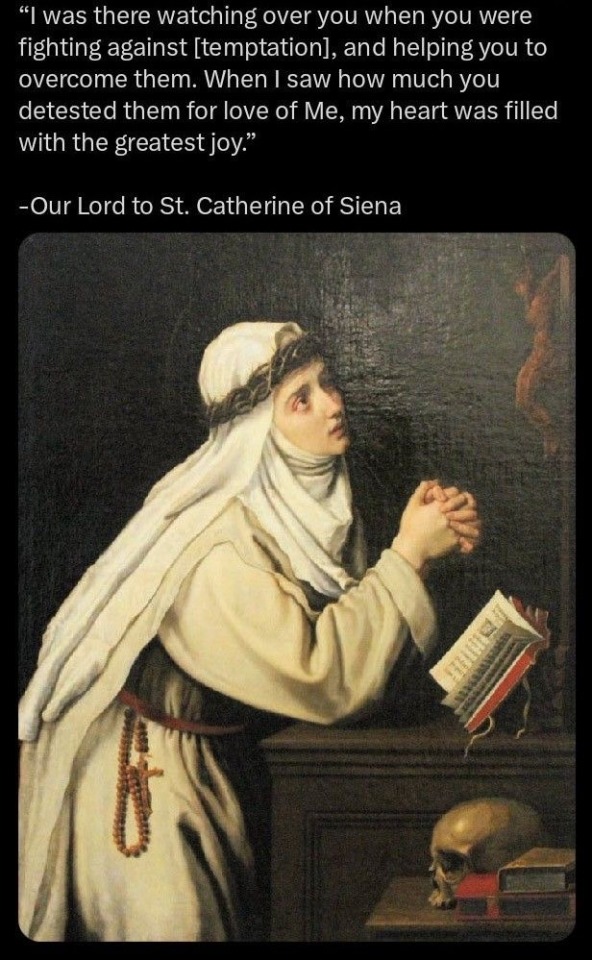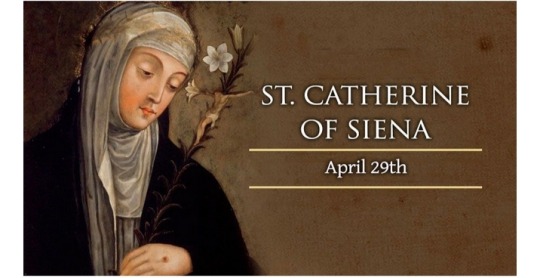#St. Catherine of Siena
Text
side b homosexual catholic saints ARE VALID!!!!
st. catherine of siena said “gay sex is soooo ew and nasty demons will encourage it and then flee the act once it’s started” and then turned around and cut her hair into a little dyke buzz cut because the thought of being attractive to men sent shivers down her (heterosexual) spine.
#therefore one can conclude that exorcisms through gay sex are possible#she’s so real#humor#happy feast day once again queen 💅🏼#st. catherine of siena#thoughts
27 notes
·
View notes
Text
Catherine of Siena

“Come to me, all ye who labor and are heavy laden, and I will give you rest.”
If we don’t know what Jesus is talking about, it sounds like a day off. Maybe the best day off ever. Because it’s God’s version of a day off, right?
Not exactly.
What Jesus is talking about is rest from the very thing that makes us heavy laden. When you and I weigh our hearts down with the desire to be someone we’re not.
When we look at other people and say in our hearts, “Why can’t I do what she does?” “How come I don’t get to do that?” “When is it going to be my turn?”
We weigh our hearts down. When we compare ourselves to others like that, we make ourselves heavy laden. And every day – even our day off – becomes a burden.
Because we’re missing what Jesus is saying. So here’s the rest of it.
“Take my yoke upon you and learn from me, for I am gentle and lowly of heart; and you will find rest for your souls. For my yoke is easy, and my burden is light.”
The yoke that Jesus is talking about is not the waste of comparison, or the burden of competition.
The truth is that as long as you compare yourself and your situation to others, you will never be anything but miserable. Because there will always be someone more successful, more talented, more celebrated than you are. This is the burden that Jesus wants you to drop.
Jesus is calling you to follow Him.
Let’s be clear, Jesus is not calling you to follow Him by being someone else. Jesus is calling you to follow Him, by being you.
Before you were ever formed in your mother’s womb, He planned for you to be here. For a moment such as this. That you are you, and that you are here now, is no accident.
And He has already given you everything you need to fulfill the purpose that He has for your life.
This is what Jesus is calling you to take upon you.
The more you live true to that purpose. The more you use what He has given you, to do what He has called you to do.
The closer you follow Him. The lighter it all becomes. The less life weighs you down.
It’s the secret of the great saints. It’s the change of heart that will change the world.
It’s what St. Catherine of Siena was talking about when she said - “Be who God meant you to be, and you will set the world on fire.”
Today’s Readings
#Who God made you to be#Who you are in God's eyes#Who you really are#St. Catherine of Siena#God#Jesus#Catholic#Christian#Church#Catholicism#Moments Before Mass
21 notes
·
View notes
Text

A Traditional Catholic stained glass window of St. Catherine of Sienna.
#traditional catholicism#traditional catholic images#traditional catholic stained glass images#traditional catholic saints#st. catherine of siena#traditional catholic saints images
355 notes
·
View notes
Text

I'm proud of myself for finally finishing this illustration. I painted it in my sketchbook and then did some final edits digitally.
I'm considering trying out giclée printing and I might start with this one. What do you think?
Here's the "about the image" and description of my process, if you're interested:
St. Catherine of Siena was one boss lady from the 14th century. She is known for a lot of things, but for this depiction of her I wanted to focus on her mission of returning the Pope to Rome (he was in France, there was a lot of political nonsense going on at the time). Her mission was a success. She was involved in peace negotiation between the Pope and the Florentines (again, lots of nonsense going on, sorry I'm not giving you the details here) and has written a great many letters that I feel called to look into. Anyway, she was working against the antipope and just overall doing a lot of diplomacy throughout her life on top of her spiritual writing and other things.
Before I began gathering reference images to put together for inspiration, I knew I wanted to focus on the aspect of her returning Pope Gregory from France to Rome.
Of all of the images I had found, I decided to include the following symbols/aspects from her life: the stigmata, crown of thorns, a rose, a lily, and the crucifix (pointing to the Vatican behind her). The red shape in front is an outline of a part of the coast of France and the green shape behind her is an outline of Italy, with the shape inside being the Vatican.
Most images of her that I found of her made her seem demure and looking away from the viewer, but for my image, I wanted her to be looking directly at you, with her arm outstretched. The lily is a symbol of purity but we know this was a bold and direct woman of God, not someone hiding in a soft expression. So, not only is she reaching out to Pope Gregory, asking for his return to Rome, but also, reaching out to you, personally, to return to the Church, if you have fallen away.
This was my collage that I made to use for reference as I painted:

Her left hand that is outstretched is my own hand, lol, so I still ended up using myself as a reference (idk why, I hate using my stubby fingers as reference so if you have dainty slender fingers feel free to let me know and I'll reach out to you next time haha)
On a personal note- this image was a commission to be given as a gift to my cousin who graduated with a degree in mediation or diplomacy (I forget) and I thought St. Catherine of Siena, a well known peace negotiator, was the best choice. My cousin is also not a practicing Catholic (as far as I know) and most of her siblings are the same. I wanted to paint this illustration with that in mind, which is why I have St. Catherine extending her hand. I want to be closer with my family but sometimes I don't know how. There's been a lot of drama between my aunts and uncles, pushing so far that many of them are no longer speaking to one another. I know painting this image of St. Catherine may not act as a bridge in the regard but maybe it could be a small stepping stone.
#st. catherine of siena#catholic art#catholic#catholic tumblr#medieval history#antipope#schism#peace#watercolor#gouache#art prints#cella bella illuminations
24 notes
·
View notes
Text

45 notes
·
View notes
Photo

“Suffering in this life is small with the smallness of time. Time is no more than the point of a needle, and when time is over, so is suffering - so you see how small it is. Therefore, they [the blessed] endure patiently.”
~St. Catherine of Siena
(Image via Pinterest)
#Christian#saints#St. Catherine of Siena#suffering#time#endure patiently#when time is over so is suffering
82 notes
·
View notes
Text







not only He loves you— even more, He longs for you.
christopher west, theology of the body for beginners / laura makabresku / robyn cadwallader, the anchoress / rutilio di lorenzo manetti, st. catherine of siena holding Christ / hadewijch of brabant, visioenboek / laura makabresku / robyn cadwallader, the anchoress / st. teresa of calcutta
#catholic#catholicism#mysticism#christian#laura makabresku#st. catherine of siena#st. teresa of calcutta#the marriage bed of the Cross etc etc#file under caroline#greatest hits
373 notes
·
View notes
Text
if Alicent was actually!Catholic rather than ASOIAF's bland pseudo!Catholic, she'd be such a St. Catherine of Siena stan.
16 notes
·
View notes
Text
SAINT OF THE DAY (April 29)

St. Catherine was a third-order Dominican, peacemaker, and counselor to the Pope.
She singlehandedly ended the Avignon exile of the successors of Peter in the 14th century.
She is the co-patron of Italy and Europe.
Born in Siena, on the feast of the Annunciation, 25 March 1347, Catherine was the 23rd of Jacopo and Lapa Benincasa’s 25 children. Her twin sister died in infancy.
She exhibited an unusually independent character as a child and an exceptionally intense prayer life.
When she was seven years old, she had the first of her mystical visions in which she saw Jesus surrounded by saints and seated in glory.
In the same year, she vowed to consecrate her virginity to Christ. When, at the age of 16, her parents decided that she should marry, she cut off her hair to make herself less appealing.
Her father, realizing that he couldn’t contend with her resolve, let her have her way.
She joined the Dominican Tertiaries and lived a deep and solitary life of prayer and meditation for the next three years.
She had constant mystical experiences, capped, by the end of the three years, with an extraordinary union with God granted to only a few mystics, known as ‘mystical marriage.’
Catherine suffered many intense periods of desolation alongside her mystical ecstasies, often feeling totally abandoned by God.
She ended her solitude at this point and began tending to the sick, poor and marginalized, especially lepers.
As her reputation for holiness and remarkable personality became known throughout Siena, she attracted a band of disciples, two of whom became her confessors and biographers.
They served Christ in the poor with even greater ardor. The Lord also called Catherine to a more public life while she was still in her 20s.
She established correspondences with many influential figures, advising and admonishing them, and exhorting them to holiness, including the Pope himself who she never hesitated to rebuke when she saw fit.
Great political acts, which are attributed to her, include achieving peace between the Holy See and Florence who were at war, to convince the pope to return from his Avignon exile, which he did in 1376, and to heal the great schism between the followers of the legitimate pope, Urban VI, and those who opposed him in 1380.
She achieved this while on her deathbed.
Her Dialogues, one of the classics of Italian literature, are the record of her mystical visions, which she dictated in a state of mystical ecstasy.
In 1375, while visiting Pisa, she received the stigmata, even though they never appeared on her body during her lifetime, owing to her request to God.
They appeared only on her incorruptible body after her death.
She died in Rome on 29 April 1380 at the age of 33.
She was beatified on 29 December 1460. She was canonized by Pope Pius II on 29 June 1461.
Pope Paul VI declared her a Doctor of the Church, along with Teresa of Avila, on 4 October 1970.
Pope John Paul II proclaimed her patron saint of Europe on 1 October 1999, along with five other saints.
She is also the patron saint of journalists, media, and nursing.
4 notes
·
View notes
Text

5 notes
·
View notes
Text

A renaissance era Catholic religious art image of St. Catherine of Sienna giving to Our Lord. Artist unknown.
#traditional catholicism#traditional catholic images#traditional catholic renaissance religious art#traditional catholic saints#traditional catholic saints images#st. catherine of siena#the dominican order#dominican saints
52 notes
·
View notes
Text



Happy April, everyone!
St. Catherine of Siena's feast day is April 29th - if you have anyone in your life who is a fan of this Doctor of the Church, you could gift them this print on her feast day because I finally put them in my shop!
About my illustration and print as well as a little about St. Catherine of Siena:
This is a 5” x 7” limited edition giclée print (ten editions) on Epson Somerset Velvet - 255 gsm, certified archival paper. Each print is signed, titled, and numbered. Also, the halo on each print is hand-painted with gold gouache, giving each print a unique reflective quality. Shipping and archival picture-framing tips are included.
St. Catherine of Siena, a third-order Dominican from the 14th century, is one of the first female saints named a Doctor of the Church; patron saint of Europe, Italy, journalists, mediators, and people ridiculed for their faith.
In this image, Saint Catherine is standing between Italy and France (Italy is behind her and France is in front of her). She is holding a crucifix in her right hand, as well as a pink rose and a lily, symbols of love and purity. She is extending her left hand toward the border of France (and the viewer) calling the Pope back to Rome.
This is referencing the time during which the Pope had left Rome for the French city of Avignon, which had resulted in a crisis within the Church called the Great Schism of the West, in which multiple men backed by different kings claimed the papacy. Through her letters, Catherine persuaded Pope Gregory XI to return to Rome from France, persuading also other rulers to recognize the true pope. In addition to calling the Pope back to Rome, she was essential for diplomatic missions to negotiate a peace with Florence. St. Catherine had a gift for telling men to get off their asses and bringing peace. In my illustration, she is reaching out to the viewer, looking directly at them, reminding them of the same thing: get up and do what the Lord has called you to do.
On her head is a crown of thorns, symbolizing a vision she had five years before her death in which Christ offered her a golden crown, symbolizing earthly riches, or a crown of thorns, symbolizing the glory of heaven through suffering in this life (St. Catherine chose the latter). She is also shown with the stigmata on her hands, which she also received in a mystical vision five years before her death.
14 notes
·
View notes
Text
“I do not think that apart from the felicity of Heaven, there can be a joy comparable to that experienced by the souls in Purgatory. An incessant communication from God renders their joy more vivid from day to day: and this communication becomes more and more intimate, to the extent that it consumes the obstacles still existing in the soul… On the other hand, they endure pain so intense, that no tongue is able to describe it. Nor is any mind capable of comprehending the smallest spark of that consuming fire, unless God should show it to him by a special grace.”
– St. Catherine of Siena
6 notes
·
View notes
Text

Photo by Siddharth Setia
"Start being brave about everything. Drive out darkness and spread light. Don't look at your weaknesses. Realize instead that in Christ crucified you can do everything." St. Catherine of Siena
#quotes#St. Catherine of Siena#Start being brave about everything#being brave#start being brave#brave#God#Jesus#Christ#Jesus Christ#Father#Son#Holy Spirit#Holy Trinity#christian religion#faith#hope#love#stress reliever
15 notes
·
View notes
Text
SAINT OF THE DAY (April 29)

St. Catherine was a third-order Dominican, peacemaker and counselor to the Pope.
She singlehandedly ended the Avignon exile of the successors of Peter in the 14th century.
She is the co-patron of Italy and Europe.
Born in Siena on the feast of the Annunciation, 25 March 1347, Catherine was the 23rd of Jacopo and Lapa Benincasa’s 25 children. Her twin sister died in infancy.
She exhibited an unusually independent character as a child and an exceptionally intense prayer life.
When she was seven years old, she had the first of her mystical visions in which she saw Jesus surrounded by saints and seated in glory.
In the same year, she vowed to consecrate her virginity to Christ.
At the age of 16, when her parents decided that she should marry, she cut off her hair to make herself less appealing.
Her father, realizing that he couldn’t contend with her resolve, let her have her way.
She joined the Dominican Tertiaries and lived a deep and solitary life of prayer and meditation.
She had constant mystical experiences. By the end of the three years, it was capped with an extraordinary union with God granted to only a few mystics known as ‘mystical marriage.’
St. Catherine suffered many intense periods of desolation alongside her mystical ecstasies, often feeling totally abandoned by God.
She ended her solitude at this point and began tending to the sick, poor and marginalized, especially lepers.
As her reputation for holiness and remarkable personality became known throughout Siena, she attracted a band of disciples, two of whom became her confessors and biographers.
They served Christ in the poor with even greater ardor.
The Lord further called her to a more public life while she was still in her 20s.
She established correspondences with many influential figures, advising and admonishing them and exhorting them to holiness, including the Pope himself who she never hesitated to rebuke when she saw fit.
Great political acts, which are attributed to her, include achieving peace between the Holy See and Florence, who were at war, to convince the Pope to return from his Avignon exile, which he did in 1376, and to heal the great schism between the followers of the legitimate pope, Urban VI, and those who opposed him in 1380.
She achieved this while on her deathbed.
Her Dialogues, one of the classics of Italian literature, are the record of her mystical visions, which she dictated in a state of mystical ecstasy.
In 1375, while visiting Pisa, she received the stigmata, even though they never appeared on her body during her lifetime, owing to her request to God.
They appeared only on her incorruptible body after her death.
She died in Rome on 29 April 1380 at the age of 33.
She was beatified on 29 December 1460 and was canonized on 29 June 1461 by Pope Pius II.
On 4 October 1970, Pope Paul VI named Catherine a Doctor of the Church, which was almost simultaneously given to Teresa of Ávila on 27 September 1970, making them the first women to receive such honor.
8 notes
·
View notes
